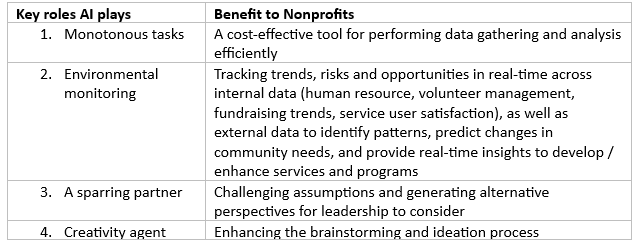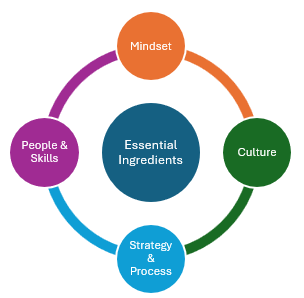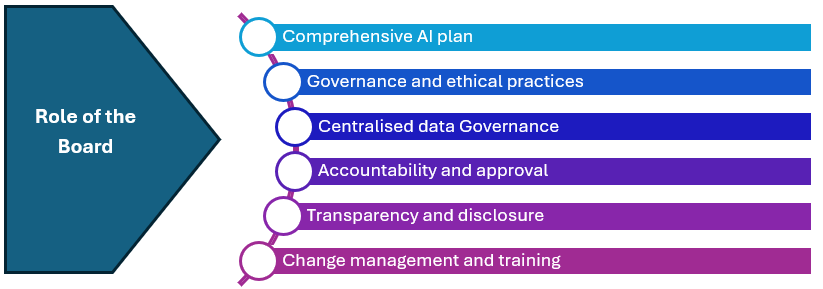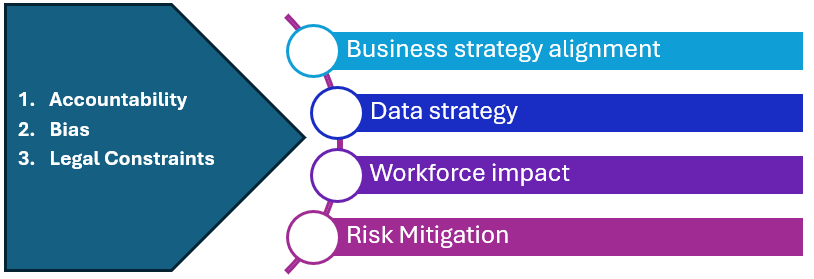Introduction
Every study and survey seem to indicate that more organisations have adopted Artificial Intelligence (AI) technologies into its operations and strategy. AI has transformed the way we operate and think,enabling more to be done with less. This breakthrough is especially pertinent to the nonprofit sector, where the strategic use of limited resources is paramount to meeting the organisation’s needs.
When organisations define their AI strategy, there are four key roles which AI typically play –

For a nonprofit to be able to effectively implement an AI strategy, it is the responsibility of the Board and executive management to first set the right conditions for AI to be leveraged, rather than misused.
Fostering the right conditions for AI adoption
As seen in Figure 1, there are four essential ingredients needed for the Board and executive management to foster the right conditions for AI adoption and integration into the nonprofit’s operations.

1. Mindset
The first thing that typically comes to mind when discussing AI are Generative AI tools such as ChatGPT, Gemini or Co-Pilot. However, it is important for the Board to reflect on AI in its broadest sense –specifically, identifying what is the organisation’s mindset towards AI?
Organisational mindsets around AI often fall into two extremes –
• Defensive: where AI is perceived as a force that could render the organisation obsolete
• Growth: where AI is seen as a massive opportunity to drive growth and innovation
From a strategic agility standpoint, mindset matters deeply because it shapes how the organisation responds. The histories of Kodak, Nokia and Borders are sober reminder of the consequences of a defensive mindset, with resistant groupthink ingrained. A growth mindset on the other hand, can enable nonprofit leadership to adapt proactively and set the tone for the rest of the organisation to follow. This includes leading by example and demonstrating what AI tools board members are using, and for what purpose.
2. Culture
Every organisation has its own unique corporate culture, shaped by its history and human capital. Whilst it is not a trait that can be reshaped overnight, there are concrete steps that nonprofit leaders can take to prepare the organisation for digital transformation. To help leaders respond to the key dimensions of organisational readiness, a human-centred framework for AI adoption should take the steps illustrated in Figure 2 –

a) Diagnose culture
Nonprofit leaders should approach the integration of AI technologies by first assessing their organisation’s cultural readiness. An effective qualitative and quantitative cultural assessment will provide critical insights to leaders and inform the organisation’s AI vision and strategic roadmap.
b) Align investment with purpose
New technology investments should align with the nonprofit’s purpose or the reason that underlies the investment. Aligning decisions about AI deployment and investment across functions and departments with elements that create the greatest value for customers or fulfil the organisation’s purpose is critical.
For example, a nonprofit with a culture that emphasises agile, collaborative decision-making using AI technologies and applications, like Miro, enhances effectiveness and reinforces its competitive differentiation.
c) Communicate a clear AI narrative
Nonprofit leaders must create a credible, engaging narrative for AI implementation that address employee concerns and fosters buy-in, energy and engagement. A key concern of employees is that AI will displace them, however, when employees strongly agree that leaders have communicated a clear plan for AI implementation, they are more likely to feel prepared and comfortable to work with AI, rather than against it.
d) Sustain adoption
New technology adoption will fail if nonprofit leaders don’t foster and replicate the right cultural behaviours. It is important to reinforce success stories, lessons learnt and best practices on an ongoing basis to maintain AI’s potential to transform the workplace.
3. Strategy & Process
As illustrated in our introduction, there are numerous roles AI can play in a nonprofit’s digital transformation strategy. However, it is important that structure and operational processes be set in place to ensure the efficacy of the strategy. Part of this process involves identifying the top critical business processes that will drive future relevance. Some examples like AI chatbots and virtual assistants to provide instant, personalized 24/7 support to service users; personalized donor and volunteer outreach for higher engagement including personalised follow-ups; financial forecasting to enhance accuracy and efficiency, among others. Whilst many processes are important, the Board should focus on the two or three processes most critical to executing the strategy. These then should receive the necessary attention, buy-in, and resources to support execution effectively.
4. People & Skills
An organisation’s human capital and skills are the foundation of successful execution. As such, it is in the interest of nonprofit leaders to futureproof their organisation by equipping employees with skills essential for the future. Figure 3 summarises the skills that have been found to be most essential for the future.

A key challenge in the nonprofit sector is employee and volunteer recruitment and retention, and with these individuals actively seeking onboarding, upskilling and reskilling opportunities, AI provides a feasible solution. Whilst manually developing and customising learning content can be time-consuming and resource-intensive, AI has the ability to create personalised, data-driven learning experiences that analyse employee performance data and align with specific organisational goals.
Another way AI reduces the barriers to professional development is by enhancing accessibility of learning. Many professionals are discouraged from pursuing further education due to time constraints and the rigidity of traditional learning models. AI addresses these challenges by enabling the development of online learning platforms that offer flexible, on-demand course accessible from anywhere, including through gamification. Using a Learning Management System (LMS), trainings can be delivered as a part of the induction/ refresher programme for new and current Board, volunteers and employees. The SGOOD training program for Boards of nonprofits in Singapore, that I have the honour of being the consultant for, is one such example.
AI has also revolutionised the recruitment process for organisations. AI-powered recruitment tools can evaluate candidates’ skills through automated assessments, ensuring a more objective, skills-based hiring process, and the matching of the right skills to the right roles.
Agentic AI Applications
Agentic AI applications represent a new frontier in artificial intelligence, where systems are not just reactive tools but proactive agents capable of autonomous decision-making, planning, and acting towards defined goals. Unlike traditional AI, which primarily assists by analysing data or providing recommendations, agentic AI can initiate actions, adapt dynamically to changing environments, and collaborate with humans or other agents to achieve complex outcomes. This evolution has opened up opportunities across industries, which we explore below. An example of this is GrantOrb, an AI grant writing platform.
a) Customer service
MigrantPal is a chatbot developed as support services for migrant worker in Singapore. Nonprofits that serve the vast migrant worker community in Singapore face common challenges involving limits to their capacity, availability, and ability to reach. As a result, migrant workers often face long wait times, language barriers, and limited access to 24/7 help.
MigrantPal leverages integrated Large Language Models (LLM) to provide 24/7 information and basic case intake for migrant workers. The chatbot’s agentic nature enables it to autonomously collect information, triage cases, and prepares them for caseworkers, reducing frontline staff load whilst handling multiple simultaneous enquiries.
b) Healthcare
Doctor Covid was a chatbot developed in Singapore during the COVID-19 pandemic to ease the workload on staff as well as reduce feelings of isolation by patients. Doctor Covid enabled close monitoring and timely clinical and psychosocial interventions through broadcasting of content in the user’s native language, and understanding of user’s risk factors and mental well-being through self-reporting functions.
The AI chatbot leverages on machine learning, natural language processing and optical character recognition to capture, analyse and respond to complex COVID-19-related questions, enabling effective two-way interactions. The responses are collected and shared as structured data with healthcare staff, helping doctors track patients without constant manual check-ins.
c) Audit
There are several offerings for organisations, including nonprofits, to automate repetitive and audit-prep steps. This includes using AI agents to automate data entry, financial reconciliations, meeting transcripts, and generating workflow templates. By leveraging on Agentic AI, nonprofits can free up human staff to focus on judgement and oversight.
d) Content moderation
Fractional AI partnered with Change.org, a platform for petitions and social causes. Change.org receive thousands of new campaigns daily, which need to be moderated to ensure compliance with community guidelines.
Fractional AI built an AI system that automatically detects a high percentage of content violations, and reduce false positives by about 46 percent. By directly integrating the AI system into Change.org’s live workflow rather than via spreadsheets, it makes the moderation process more streamlined, proactive, and reduces human overhead.
e) Inventory management
AI plays a crucial role in inventory management by forecasting demand and automating order-placement processes. Human intervention is reserved for handling exceptions or making strategic decisions. This can be especially useful for nonprofits looking to implement waste-reduction initiatives as part of their broader ESG strategy.
Role of the Board of Directors
Expanding on our introduction, the Board members are responsible for setting the strategic direction, ensuring oversight, and embedding governance for the responsible adoption of AI, including agentic AI. Ultimately, the role of the Board is to ensure a balance between technological innovation and robust safeguards, which is illustrated in Figure 4

Beyond the responsibilities listed above, the Board’s use of AI presents three key governance benefits to the organisation.
a) Regulatory conformance
AI provides the tools to streamline compliance monitoring by identifying anomalies, automating repetitive tasks and tracking regulatory changes in real time. This could include revisions to the Charity Council’s Code of Governance. Generative AI systems like ChatGPT can simplify and summarise complex legal texts into actionable insights for board discussion.
In the near future, if organisations ledgers adopt blockchain-based systems, AI could simplify verifying financial accuracy to the point of real time audits, reducing complexity and cost of audit functions and freeing up directors to focus on strategic oversight.
b) Driving performance
AI tools will be an essential part of the decision-making process, helping to optimise supply chains, modelling financial scenarios and generating actionable insights. Through predictive analytics, AI can highlight underperforming areas, recommend corrective actions, and forecast future outcomes based on macroeconomic or organisational variables.
Some organisations have already included AI algorithms in its decision making, including Deep Knowledge Ventures. The organisation famously assigned voting rights to its AI algorithm on investment proposals, evaluating factors commonly overlooked by humans and providing an additional later of decision-making rigour. Investment committees of nonprofit could explore such innovative ways of strengthening its decision-making processes.
c) Future-proofing the organisation
AI is proving indispensable for long-term planning, offering predictive insights into trends and risks. Generative AI enables boards to simulate scenarios across different domains, from technological shifts to global crises, and formulate strategies accordingly.
For example, IBM’s AI-driven Watson is used by businesses to map out potential risks and opportunities stemming from market disruptions or environmental factors, ensuring boards can adapt and innovate before crises arise.
Concerns around AI integration
Whilst AI’s potential is vast, Board members need to address the significant ethical and legal considerations surrounding accountability, bias, and legal constraints, before formally including such tools into Board decision-making. Nonprofit leaders, be it Board members or senior management, need to also work together to ensure AI initiatives align with organisational strategy, values, and risk appetite.

Beyond the broader concerns listed above, AI also presents specific risks that can negatively impact the quality of outputs. These include the following key risks –
a) Bias and fairness
AI systems can perpetuate biases in their training data, leading to unfair or discriminatory outcomes that damage reputation and trust.
b) Regulatory compliance
Laws and regulations in the AI space around the world are evolving. Boards must ensure the organisation stays ahead of regulatory requirements.
c) Data privacy and ownership
AI replies on vast amounts of data, raising questions about data ownership, privacy, and security.
d) Cybersecurity threats
AI systems are vulnerable to cyber-attacks that could disrupt operations or expose sensitive data
e) Ethics and workforce disruption
AI will reshape jobs and industries, leading to ethical dilemmas around job displacement and the societal impacts of automation.
Risk Mitigation Measures for AI
Risk mitigation measures are essential for balancing innovation with responsibility, especially when adopting new technologies like AI. They can provide nonprofit leaders with structured approaches to identify, assess, and manage potential threats before they escalate into significant issues.
a) Human-in-the-loop
Application owners are advised to scrutinise agentic processes, identifying specific junctures where human oversight is not just beneficial but necessary. For instance, significant financial transactions facilitated by AI agents should be designed to require a human review before the transaction is finalised and executed.
b) AI-powered automation
Centralised governance of AI-powered automation can optimise end-to-end workflows. Ensuring that automation processes include scalability and human-in-the-loop principles. This can help safeguard the organisation against unintended consequences while supporting efficiency.
c) Scaleable infrastructure
Adopt scaleable cloud solutions to support the growth and flexibility of AI systems. This enables vertical and horizontal scaling for efficient model hosting, performance optimisation and seamless user access.
d) Safety and trust mechanisms
Safety mechanisms must be integrated into the AI development lifecycle. These include rigorous testing during development and before deployment to ensure the system is reliable and trustworthy. This builds user confidence and minimizes operational risks.
e) Technical debt management
These are the compromises and shortcuts in system development that make future development and maintenance more difficult and expensive. Hence nonprofit leaders should adopt best practices to minimise technical debt in their AI tech stack. Technical debt occurs when software or codes are designed sub-optimally, resulting in codes that are difficult to understand and scale.
f) Deepfake and scam awareness
Implement robust security measures to detect the creation and circulation of deepfakes, ensuring that such deceptive content is identified and addressed promptly.
Conclusion
AI offers nonprofit leaders both a transformative opportunity and a strategic responsibility. By leveraging AI thoughtfully, leaders can streamline operations, unlock new avenues for service delivery, and strengthen governance, while ensuring that risks are carefully managed. Success depends not just on adopting new tools, but on cultivating the right mindset, culture, and skills across the organisation, with boards playing a pivotal role in balancing innovation with accountability. For nonprofits, AI is not simply about technology—it is about aligning intelligent systems with purpose, empowering people, and building resilient, future-ready organisations that can deliver greater impact for the communities they serve.









